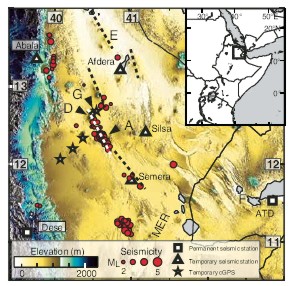Keir et al, 2009b
Evidence for focused magmatic accretion at segment centers from lateral dike injections captured beneath the Red Sea rift in Afar by D. Keir et al, 2009
Non-technical summary
The breakup of the Earth’s crust as the tectonic plates move apart occurs by repeated episodes of stretching and dyke intrusions along rift zones. A dyke is a vertical injection of magma from deep in the Earth’s crust. As the magma in the dyke crystallizes it forms new rock and so accommodates the movement of the plates. However, the time and length of the dyke intrusions together with the depth at which the source of the magma lies is uncertain. Rift zones are divided into segments which are offset from each other along the rift zone. Studies of the currently active 60-km-long Dabbahu segment of the Red Sea rift in Afar have used information from satellite radar, global positioning systems and seismicity (records of the waves of energy created by earthquakes used to interpret the structure of the Earth’s crust) to capture the emplacement of two 10-km-long, 1–2-m-wide dyke intrusions in June and July 2006. Observations of these dykes show that they were injected along the rift over about four to five hours and that the source of the magma was in the lower crust or upper mantle beneath the centre of the magmatic segment. As the magma was injected into the upper 10km of crust it caused earthquakes and faulting at the Earth’s surface. Also, the continuing injection of dykes from a magma source beneath the individual segment (as opposed to a magma source that stretches the length of the entire rift zone) helps create and maintain the pattern of magmatic segments.
Full paper (pdf file)

Figure 1: Earthquakes during April–August
2006 recorded on temporary broadband
seismic stations (triangles) and permanent
short period stations (squares). Seismic
stations are in named towns (ATD—Arta,
Djibouti ) and stars denote continuous global
positioning system (cGPS) stations. Major
volcanic centers: A—Ado’Ale Volcanic Complex,
D—Dabbahu , E—Erta’Ale, F—Fielle,
G—Gabho. Dashed white line shows axis of
Dabbahu segment; dashed black lines show
axes of other subaerial Red Sea rift segments.
Top right inset shows location of Afar.
